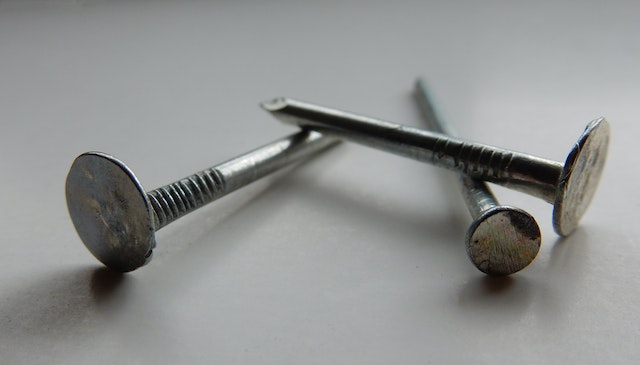
When did people start using nails? Bronze nails were used in Ancient Egypt in about 3,400 BC.
Before people had nails, there were different ways of joining wood together. Some of these techniques are still used today. The most basic way of joining wood to wood was with wood glue. Animal glues have been used for nearly 6,000 years. It is fairly easy to make. The connective tissue of the animal has to be boiled down until it forms a glue. Carpenters could also make joints out of the wood, such as mortice and tenon joints. Pegged construction was another way of making things out of wood. A wooden peg would be driven through a hole in the pieces of wood, holding them together. Even when nails appeared, many carpenters refused to use them because they didn’t see it as proper carpentry.
The nails found in Egypt were made of bronze and they were handmade. They were all a slightly different shape. Bronze was the only metal available to people at the time, but bronze is not the best choice for a nail because it is a very soft metal. It would lose its shape very easily when hammered into any type of wood that was hard. Bronze was also an expensive metal, which is probably why there are not many examples of bronze nails.
The Bronze Age was replaced by the Iron Age in roughly 1,000 BC (although it varied all over the world and there is close to an 800-year gap between the first places to adopt iron and the last) and people started to make nails out of iron. Iron is a much stronger metal than bronze and it would have been easier to hammer. Still, at the start of the Iron Age, most people made things using wooden joints. It was only with the Roman Empire that iron nails started to become more common. The trade of blacksmith came into its own, and they made a huge number of iron nails. Every Roman fort would have had a blacksmith and when the Romans abandoned their fort at Inchtuthil in Scotland, they left behind seven tons of iron nails. They made them by heating iron ore with carbon to make square rods, which were then hammered and cut repeatedly until they had nails. Roman nails were square-shaped because it is easier to hammer something square than round.
After the Roman Empire disappeared, people continued to use Roman style square nail. Throughout the Middle Ages they used these nails, but the nail heads became more and more elaborate. A lot of Medieval buildings have doors that are studied with intricate nails. Nails were still made by hand and the job was divided between two people. The first was the splitter who prepared the metal and formed it into a rod, then there was the nailer who was the person responsible for finishing up the nails. They were artisans and it is where the surname Naylor comes from. Nails were still fairly expensive and were not used everywhere.
In 1590, in England, the slitting mill was invented. This was a watermill that used water power to slit bars of iron into rods. It did away with the job of the slitter, but the nailer was still needed to shape the rods into nails by hand. It was technically an automated nail machine, although most of the work was still done by hand.
The Industrial Revolution brought about the invention of nail making machines and the profession of nailer disappeared. The Industrial Revolution made precision machinery possible, and it introduced steam engines. The first nail machines were introduced in the late 18th century, and they cut iron bars into rods and then into nails. Another machine cut nails out of sheets of iron. These machines brought down the cost of nails, but they were still nowhere near as cheap as they are today.
Iron nails were popular until the 1860s when they were replaced by wire nails. Wire nails are made from steel wire which is drawn through a machine and then cut with a blade to make the point. Steel was cheaper than iron and the machines could make so many of the nails so quickly that their price quickly dropped. By the start of the 20th century, nails stopped being rare and were used for everything, the way that they are today. It also became possible to make nails in a whole range of sizes. And this is what I learned today.
Photo by Anne Kruse: https://www.pexels.com/photo/3-flat-head-nails-close-up-photography-190101/
Sources
https://www.designingbuildings.co.uk/wiki/The_history_of_nails
https://inspectapedia.com/interiors/Nails_Hardware_Age.php
https://en.wikipedia.org/wiki/Nail_(fastener)
https://en.wikipedia.org/wiki/Animal_glue
https://www.nps.gov/articles/watch-those-thumbs.htm
https://kids.britannica.com/kids/article/Bronze-Age/352883
https://www.history.com/topics/pre-history/iron-age
